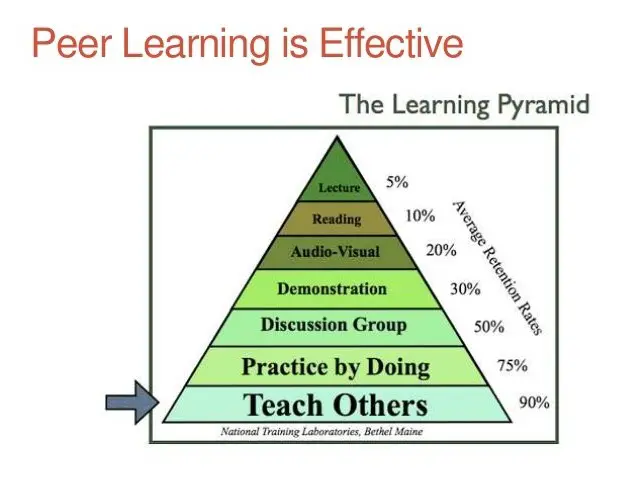Recent studies show that companies are more interested than ever in the Learning & Development of their employees. Corporations know that investing in the professional development of their employees means better revenues. An ultimate win-win situation for all. Hence why HR departments now stress the importance of setting up Peer Training programs in organizations. It is when employees teach and learn collaboratively from the experiences of one another that the company really flourishes as one.
Such collaborative training helps improve cross-team sharing of institutional knowledge and dismantles the monopoly of information. Moreover, by emphasizing collaboration, it builds trust and reliability in the working community, making for an efficient work environment.
Let's learn why Peer Training is a must-have in the workplaces of 2022.
What is Peer Training?
Peer training is a sub-branch of Peer Learning - a social learning strategy that puts emphasis on learning from one another as peers. Developed in the 1980s, social learning has been in use since due to its several benefits. More recently, companies have begun to incorporate it in their offices to reap its benefits.
It essentially requires that companies pair up the employees for tenure. They learn together, help one another through professional - even personal - problems and work as one unit. In this entire process, a mentor is also placed who overlooks and leads the learning process wherever necessary.
Benefits of Peer Training

Facilitates deeper learning
Studies prove that when learning in active collaborative environments, learners perform better. This is because learners receive individual assistance and extra attention that they would otherwise miss. It is also arguably better than the traditional 'banking learning' style where the instructor spoon-feeds. Rather, the instructor is a mere moderator and works alongside the learners. Such a setup fosters critical thinking and improves self-confidence.
Moreover, employees who are experiencing things first-hand respond differently to the same knowledge that a 'by-standing' L&D professional would. Hence why peers make for better teachers too at times.
Fosters community building
The corporate world is has been called out for being too competitive and hence unhealthy. Peer training essentially demands that people work alongside rather than compete. It takes away any feelings of workplace insecurity and builds stronger professional relationships.
Democratizes knowledge sharing
As opposed to the traditional transfer of information within an organization that follows a rigid top-down model, this training follows both vertical and horizontal knowledge sharing. It makes communication channels efficient and also improves the content of the information as more people get to share it.
Improves company revenues
A stronger and motivated team makes for an efficient workplace. Hence, the company performs better and in turn generates higher revenues. Matter of fact, companies that invest in the L&D of their employees report 23% higher profits.
Cheaper than other corporate trainings
The overall cost of designing and then constantly updating a training program can be a bit pricy. With Peer Training, learners are constantly evolving the content of learning themselves hence a need for an additional L&D onlooker is not necessary. The program exists like a growing and adapting being that is intrinsically capable of modifying itself as per the changing requirements of the organizations.
Implementing Peer Training in workplaces
Collaborative training in workplaces usually follows a four-tier process - AKA - the learning loop. It is broken up as follows:
- Gaining knowledge
- Knowledge application
- Receiving feedback
- Reflecting on the content learnt.
To successfully implement peer learning in the workplace, all these four steps must be carefully met. Here's how...
During employee onboarding
Employee onboarding is a time-taking and often a boring task, nevertheless, crucial. To reduce the additional burden from HR managers, a pro-tip is to assign peer mentors to the newcomers for early work assistance. These mentors will take care of the tedious job of giving the new recruits the tours and basic company policy information. Moreover, they will help new recruits fully settle in.
Another great strategy of implementing peer training is via an LMS or onboarding platforms. Teachfloor comes fully equipped with fundamental tools like peer review features, Zoom integration, and discussion forums to help employees connect from every corner of the world. L&D creators can even build a content library on Teachfloor that future employees can use when needed.
Finally, for swifter onboarding, set up a workplace network where employees can interact instantly and share knowledge with the click of a button.
During constant performance
Once we move forward from the onboarding stage, companies are met with the dilemma of keeping the interests and knowledge growth of the employees going. To implement the strategy in employees' everyday work-life in it is recommended to hold group meets and company mixers. Such informal or semi-formal meet-ups can also contribute to employee learning. They help the people to relax while also making key professional contacts and seeking guidance from their superiors.
For this, HR managers can use Slack channels or even social media platforms such as Facebook, where employees can engage in a fun yet meaningful way. Teachfloor offers a discussion wall exclusively for facilitating such meaningful employee engagements.
During review process
The final stage where peer training plays an important role is during the company review process. At the end of a session, ask the participants to provide constructive feedbacks concerning their peers. This way peers will learn where and how they need to improve their performance. Additionally, L&D experts in the company can also learn how they need to modify the overall training program.
Steps to setup Peer Training program
- Nominate a peer-learning facilitator: These facilitators act more like moderators who give direction to the program and only interject when the peers ask for guidance. They ensure that the quality of the program remains up to mark.
- Create safe and encouraging environment: It is important for better learning that the environment is encouraging. Employees should be made to feel welcome and safe when exchanging their opinions. Only such a healthy dynamic will make for quality peer relationships.
- Setup networking event
- Pair new recruits with experienced professionals
- Keep track of the sessions: This refers to note taking for documenting the contents of the sessions for future review. It can also help in establishing the knowledge library for the company for future employees.
Future is Peer Training
According to a McKinsey report, 70% of the organizations now stress skill building than they did before the pandemic. This trend shows that more companies believe in the benefits of investing in the professional growth of their employees. Given the rapidly changing needs of the world, this isn't shocking at all. In fact, these numbers will likely project higher in the coming years.
%201.svg)


.png)

.webp)


.webp)
%201.svg)